
|
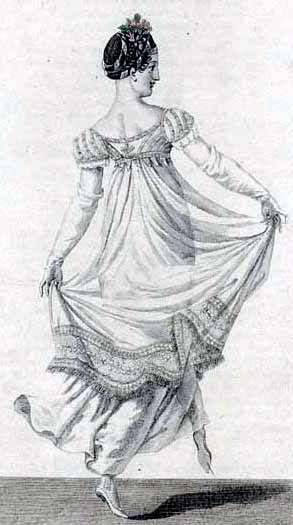
|
AN OVERVIEW OF EVENING FASHIONS 1800-1820
This page is a guide to introduce the evening dress styles of the early
19th Century to aid in the design and construction of a period ensemble.
Included are descriptions of the components of an evening outfit, including undergarments and accessories.
Hairstyles, jewelry and headdresses are discussed as well. There is also some sewing advice and a list
of patterns that might be useful, as well as some books and websites with useful information, and finally, places
to shop in the Boston, MA area.
The styles of the early 19th Century are known by several different names,
depending on what country you are describing:
- Regency (England, 1811-1820)
- Federal (United States, 1785-1815)
- Napoleonic (France, 1799-1815)
|
|
Evening Dresses
|
|
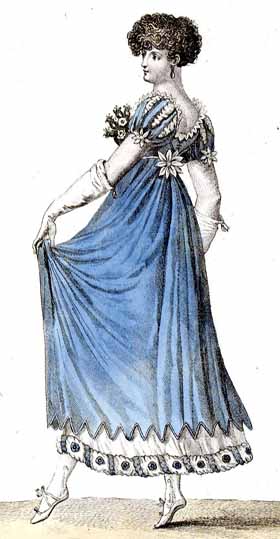 WAISTLINE:
WAISTLINE: - The prevalent silhouette
is most notable for its very high waistline, which only changed slightly throughout the period,
- ranged from a couple of inches below the bust, to just below the bust, or even, especially if one
was large busted, slightly on the bust itself
- the exact placement of the waistline depended
on the prevailing fashion of the season.
BUSTLINE:- The bust was lifted and separated by the stays
- with the breasts clearly separated
- without cleavage
NECKLINE & BODICE:- Necklines were open
- the exact shape varying as fashion dictated
- The bodice
most often had a back opening with drawstring ties at the waist and neckline, a bib-style front opening
with attached underbodice or a V neck in front.
SLEEVES:- Sleeves can be short and slightly puffed
- elbow length or long
(short puff over a sheer long sleeve for example).
SKIRT:- The skirt is generally flat or slightly gathered in the front, slightly flared, with rectangular gathered panels at
the center back
- The hem length varied throughout the period and there were no trains on dancing dresses.
1807 Dancing Dress
|
|
COLORS & FABRICS: - White was very popular, inspired by ancient Grecian modes, in cotton,
linen or silk
- White on white embroidery was fashionable
-
Light sheer overdresses in colorfully embroidered net or fine sheer silk, over satin, in
contrasting colors was also fashionable
- Trim could be seen at the hemline, neck, waist, sleeves and
down the front of the dress.
|
Some Neckline Variations Throughout the Period
|
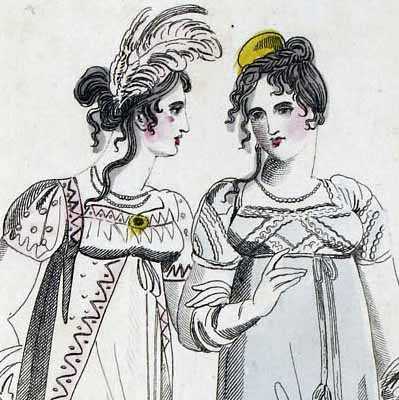
1801
square neck, not low cut, angles inward as it approaches the shoulder. Back is fairly narrow.
|
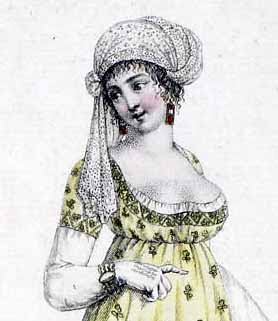
An 9 (1800-01)
Wide scoop neck. Chemise showing or part of the dress.
|
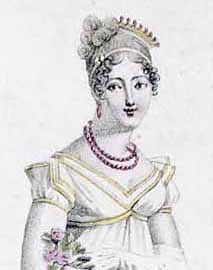
1812
Wide V Neck
|
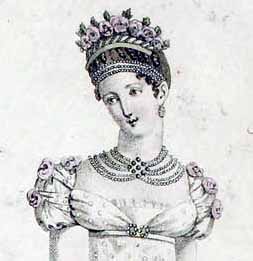
1812
Wide square neckline
|
|
Undergarments
To achieve the period silhouette and support your dress properly the correct
undergarments are very helpful.
Contrary to popular belief, corsets and petticoats did
not disappear during this period.
CHEMISE (Shift)
- The chemise is a fairly simple shift style, with very simple shaping, open,
square neckline
- with or without a drawstring and short sleeves with gusset
- in either lightweight
linen or cotton
- worn under the corset to help keep the corset clean, and to protect
the body from the corset
- knee or mid-calf length, minimal decoration-a hard-working, simple garment.
|
CORSET (Stays)
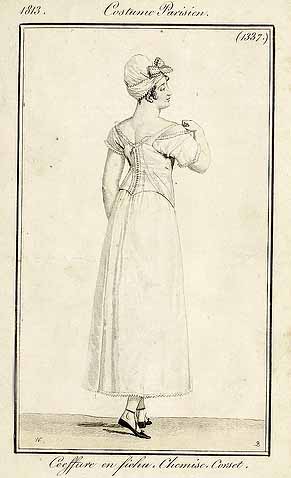
Contrary to popular belief, corsets were worn in this period. To achieve the
proper high-waisted silhouette, the corset is invaluable.
This period was one which was transitioning
from the fully boned 18th Century stay that transformed the figure into a very smooth artificial shape
and flattened the bust, to one which followed the natural curves of the body and supported them more
gently.
- The bust can be shaped by gussets or gathered bust cups
- it usually had shoulder straps.
- The bust was supported rather than squished together
- cleavage was not desirable.
- Litle boning is used, if any at all, cording was used to provide a bit
of stiffening.
- Lengths varied year to year as fashions changed; those who need more support could
choose a longer corset, which flattens the stomach and hips.
- Those with very slim figures can choose
a shorter style which mainly supports the bust. (Very short stays came into fashion around 1810)
- Fabrics are firmly woven cotton or linen, medium weight.
1813 Corset and Chemise
Return to Top
|
Evolution of corset types
1790s-1820s (illustrations courtesy of Past Patterns)
|
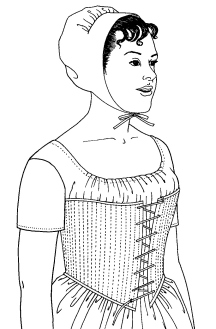
1796-1806
Transition Stay
smooth bustline, short corset, fully boned
|
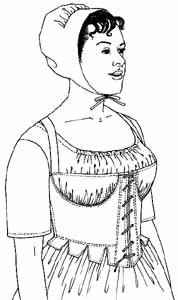
1793-1820
Transition Stay
shaped bust cups and minimal boning
|
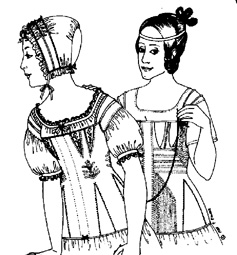
1820s-1840s
Corded Stay
longer corset, front busk, smooths the hips, supports the
bust without much waist compression
|
|
|
PETTICOAT
- The petticoat had either shoulder straps to hold it at the unnaturally high waist
or an attached under-bodice of slightly heavier
cloth—this garment is called a petticoat body—that might even take the place of a corset
- The line of the petticoat follows the basic
shape of the dress
- For styles fashionable later in the period the hem can be corded if more body is desired
- Petticoats
were made of cotton, linen or fine wool flannel.
- In the period the term petticoat refered to a skirt, not an undergarment.
Additional Undergarments, these are not as commonly worn
DRAWERS & PANTALOONS
- Drawers appear in ladies clothing after 1800 and didn’t seem to be commonly worn
until the 1830s
- Their design was based on men’s drawers
- Pantaloons, on the other hand,
are long drawers with decorated bottoms that are meant to be
seen, they eventually became a child’s fashion only
- Pantaloons were a short lived fad for ladies.
BUSTLES
- Small bustle pads could be attached to the dress at the back waist to keep the skirt
from collapsing into the small of the back
- The pad was a very small pillow, about 1-2"wide and 6" long.
Return to Top
|
Accessories
|
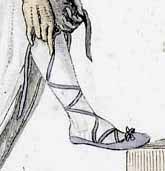
GLOVES, SHOES & STOCKINGS
- Long white kid leather gloves are the most common.
- Other colors appeared and disappeared as fashions and the latest fads changed.
- Slippers, flat, of white satin or kid with decorative ribbons or rosettes.
- Stockings usually white cotton or silk, opaque.
FANS, POCKETS, PARASOLS, & RETICULES
- Fairly small folding fans (paper or silk leaf) or round forms are fashionable.
- A good modern
alternative is a Japnese paper or silk fan or small vintage fans ca. 1910 which are quite similar in
proportions and designs to early 19th-century styles.
-
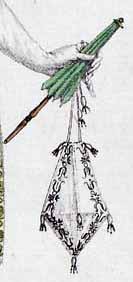 A pair of pockets can be worn under the dress attached by a tape at the waist.
A pair of pockets can be worn under the dress attached by a tape at the waist.
- Pockets were not particularly fashionable so a reticule (also called a ridicule or indipensible)
or small cloth purse, can be carried to hold indispensable items.
- Parasols have long narrow handles and delicate covers, in colored silk.
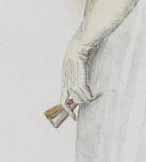
|
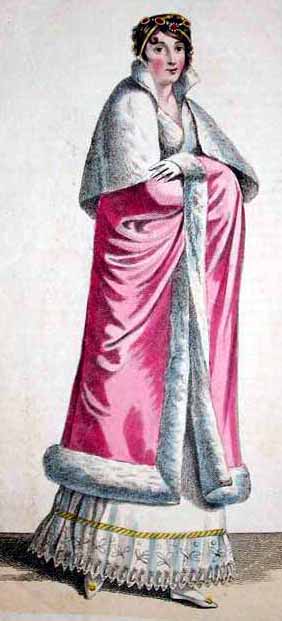
PELISSE & SPENCER
- The Pelisse is an outdoor garment
- the equivalent of a coat
- with or without sleeves
-
to be worn over one’s dress
- Short, three-quarter length or long and front opening
- The Spencer is
a short jacket worn over the dress, long sleeves, front closure
- Mainly an outdoor garment
- might
be worn for evening wear indoors
- Fabrics vary.
CLOAKS & SHAWLS
- A loose cloak can be worn
- Shawls are large, long rectangles or large squares folded
crosswise
- wool, wool and silk blend,
or very lightweight cotton
- often with Indian paisley
designs or white on white embroidery.
|
Hairstyles, Head-dresses & Jewelry
|
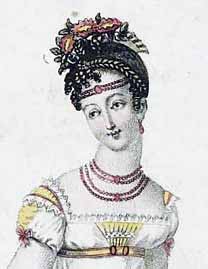
|
JEWELRY: - Simple pearl or bead necklaces
- cameos
- classical style earrings finish the ensemble
- Bandeaus in the hair or on the forehead
- Tiaras in neo-Classical styles
- Jewels
with neo-classical motifs and designs were very fashionable
|
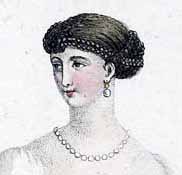
|
Return to Top
|
|
|
|
Return to Top
|
Deciding on a style
Where to do your research
|
Research Resources
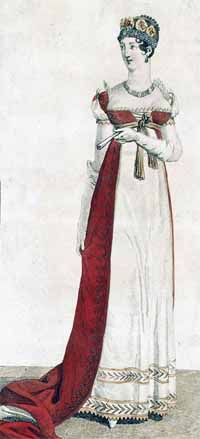
Before you start making your outfit it is a good idea to do some research
to help decide what style you want your ensemble to copy. Museums, blogs and history websites, libraries
(physical and on-line) and movies are great places to start for visiaul references.
Museums:
- Many museums have virtual catalogues of their collections, through searches you can access lots of photos
of original garments
li>Some of the best have large enough images so you can see details of construction
- Even better are actual real life exhibitions of clothing but they are usually few and far between
- Portraits also usually give a somewhat idealized view of what was actually worn, expecially what accessories were worn in
different regions, level of society and situations
- Exhibition catalogues are useful too.
Blogs & Pinterest:
- There are many blogs out there that either focus on one period or just pretty gowns (see OMG That Dress below) for me to list here
- Great for images,
literary references, and pointers to other resources
- Pinterest is also a great source of period images.
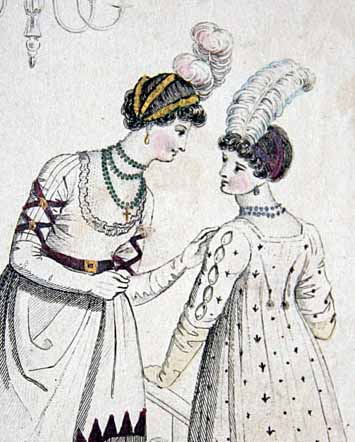 Libraries:
Libraries:- There are on-line databases of books and fashion plates, a great way to access rare resources
- If you are lucky enough to
live near a big city with a good library check them out to see what they might have
- Fashion
plates give an indealized view of what was worn by the most fashionable folks.
Films:- Period movies can give insight into how the clothing moves
- Watch period films with a critical eye—notice what they did
right, what they ignored or what they simply got wrong
- become aware of what symbolism the color or style choices have that may superce historical accuracy
- Often the secondary characters are more historically accurate that the stars.
|
Websites, Patterns & Books
|
WHICH PATTERNS TO CHOOSE?
How do you make the decision of which historical pattern to choose?
- There are several small pattern companies that produce only historical patterns. Whenever
possible I prefer to support these independent publishers who have good products
- Even when using any of the
patterns listed below combine ther use with research of your own (see previous paragraph)
-
You’ll have better success the more you know before starting sewing
- Also, when using any commercial pattern
that may be used by other ladies attending the same events, making changes to neckline,
sleeves and trim will ensure that you won’t walk into the ballroom to face several dresses
identical to yours!
- The same is true about copying an iconic dress from a movie or painting—you
may find another identical dress facing you at an event.
|
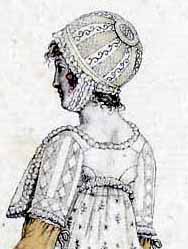
1801, back view, notice the placement of the shoulder and back seams creating a diamond shaped back panel.
|
|
HIGHLY RECOMMENDED PATTERNS
Past Patterns: The company I reccommend most often is Past Patterns.
The patterns are taken from actual period garments or
antique patterns, with complete, tested, professional sewing instructions, and often the patterns come
with exhaustive historical notes. Most patterns are available in a wide range of modern sizes or, if it is one of the
Vintage Revivals patterns, just the original period size.
Janet Arnold, Patterns of Fashion: Next I would recommend the books by Janet
Arnold. Her Patterns Of Fashion books contain reduced scale drawings, on grid paper, of patterns taken
from actual garments. Guaranteed to be historically accurate in period sizes.
Past Patterns, used in combination with Janet Arnold (especially if you are a petite period size)
and Nancy Bradfiel’s Costume in Detail (see below) will help give you a good, accurate, historical
recreation.
RECOMMENDED PATTERNS
Folkwear: Folkwear has a good basic Regency dress pattern a basic style that is fairly simple to make.
Sense & Sensibility & La Mode Bagatelle: Sense & Sensibility Patterns and La
Mode Bagtelle Patterns offer a slightly wider range to balance out the offerings,
especially additional undergarments. Slightly less acurate than Past Patterns
or Janet Arnold but still good patterns.
When using these look at period illustrations and garments to tweak the dresses, like adjusting shoulder seam placement,
for a better fit and period line. There are also other smaller pattern companies that I, as yet, have no experience with
so I cannot review them.
COSTUME PATTERNS
Then we come to the large commercial pattern companies, mainly Simplicity and Butterick. Neither of them
is particularly accurate, though Simplicity is better than Butterick, they are, in the end, costumes.
Don't expect an accurate look straight from the pattern, or a comfortable dress for dancing (the
skirts are usually not cut full enough for dancing). Simplicity is a bit better but will still need alterations for a more accurate look.
Return to Top
LISTING OF REGENCY PATTERNS
Past Patterns
Undergarment, corset, dress and military jackets patterns from the Regency or Federal Era.
- #002: Two Early Nineteenth Century Chemises.
- #001: 1820s-1840s Corded Stay.
- #030: A "Transition Stay" Fashionable Circa 1796-1806.
- #031: Circa 1796-1806 Lewis & Clark Era Front Closing Gown.
- #038: A Partially Boned "Transition Stay" Fashionable Circa 1793-1820.
- #040: Napoleonic Era British Foot Soldier's Jacket circa 1806-1820.
- #041: U.S. Army Roundabout Matching 1812 Specs.
Arnold, Janet. Patterns of Fashion 1: Englishwomen’s Dresses and Their Construction 1660-1860.
Drama Publishers, ISBN: 089676026X
Patterns taken directly from ladies garments, 1/8 scale. An excellent resource.
- 1795-1810: Half Robe
- 1795-1803: Robe
- 1795-1810: Riding Habit
- 1798-1805: Morning Dress
- 1806-09: White Embroidered Muslin Frock
- 1800-25: Chemisettes
- 1818-23: Pelisse
Sense and Sensibility Patterns
Dress, spencer & undergarment patterns.
La Mode Bagatelle
- La Mode Bagatelle, Regency Wardrobe Pattern
A wardrobe of regency patterns. (out of print but may be available again in 2012)
Folkwear Patterns
- #215 Empire Dress (simple basic style, a little low cut in the bust)
Simplicity Patterns
- #4055
Regency Dresses (not completely accurate, skirt is not full enough, shoulder seams are too far forward)
- #4052
undergarments (out of Print, used copies might be available)
Butterick Patterns
- #6630 not recommended.
(skirt is not cut on period lines, it is not nearly full enough and does not fit properly if you have hips,
do not do the back eyelet lacing!)
Books with Patterns
-
Arnold, Janet. Patterns of Fashion 1: Englishwomen’s Dresses and Their Construction 1660-1860.
Drama Publishers (1977); ISBN: 089676026X
Patterns taken directly from ladies garments, 1/8 scale. An excellent resource.
-
Doyle, Robert. Waisted Efforts.
Sartorial Press Publications (1997); ISBN: 0968303900
Corset patterns, history, and fitting.
-
Hunnisett, Jean. Period Costume for Stage and Screen, Patterns for Women’s Dress 1800-1909.
Players Press, Inc. (1991), ISBN: 088734609X
Theater related patterns, tips and hints.
-
Waugh, Nora. Corsets & Crinolines.
Routledge (1990); ISBN: 0878305262
Undergarments with reduced scale patterns and historical notes.
-
Waugh, Nora. The Cut of Women’s Clothes 1600-1930.
Theater Arts Books (1987); ISBN: 0-87830-026-0
Reduced scale patterns and costume history by era.
Return to Top
Other Publications
Exhibition Catalogues, Fashion History Books, Fashion Plate Albums, Reprints
Ackermann, Rudolph (Author); Blum, Stella (Editor).
Ackermann’s Costume Plates: Women’s Fashions in England, 1818-1828.
Dover Books, 1979. ISBN: 0486236900
Color reproductions of English fashion plates.
Barreto, Cristina. Napoleon & the Empire of Fashion: 1795-1815.
Martin Lancaster, 2011. ISBN: 8857206505
Exhibition catalogue.
Napoleon & the Empire of Fashion Website
Bradfield, Nancy.
Costume in Detail: Women’s Dress 1730-1930.
Costume & Fashion Press, 1997. ISBN: 0896762173
Detailed sketches of clothing construction. Details many of the dresses in Patterns of Fashion by Janet Arnold.
Cunnington, C. Willett. English Women’s Clothing in the Nineteenth Century.
Dover Books, 1990. ISBN: 0486263231
Year by year breakdown of each era, very thorough.
Downing, Sarah-Jane. Fashion in the Time of Jane Austen.
Shire Library, 2010. ISBN: 0747807671
Over view of the period covering fashion and society in England.
Le Bourhis, Katell.
The Age of Napoleon: Costume from Revolution to Empire, 1789-1815.
Harry N Abrams, 1990. ISBN-10: 0810919001
Exhibition catalogue from the Metropolitan Museum of Art.
Johnston, Lucy. Nineteenth Century Fashion in Detail.
V & A Publishing, 2009. ISBN-10: 1851775722
Detailed photographs of period garments.
A Lady. The lady’s economical assistant, or, The art of cutting out, and making, the most useful articles
of wearing apparel, without waste.... (1808).
Kannik's Korner, 1998. ISBN: 0964016133
Period reprint.
Sadako Takeda, Sharon; Durland Spilker, Kaye; Galliano, John.
Fashioning Fashion: European Dress in Detail, 1700 - 1915. Museum exhibition catalogue 2010.
Prestel USA, 2010. ISBN-10: 3791350625
Exhibition
at the Los Angeles County Museum of Art.
Return to Top
Links
Suppliers, Pattern Companies, Blogs, On-line Guides
- Burnley and Trowbridge (http://www.burnleyandtrowbridge.com)
Buckles, books, clothing accessories, fabric, patterns, notions &tools, shoes, tapes & trims.
- G. Gedney Godwin (http://www.gggodwin.com/)
Military equipment, men’s & women’s clothing, shoes & buckles, books
- Kanniks Korner (http://www.kannikskorner.com)
Patterns for clothing and accessories for men & women 1730-1830, books
- Past Patterns (http://www.pastpatterns.com)
Patterns for men, women & children from the late 18th century to WWII
- Reconstructing History (http://store.reconstructinghistory.com)
Patterns, clothing, notions
- Wm Booth Draper (http://www.wmboothdraper.com)
Patterns, notions, fabrics, accessories
- Regency Costume Basics
(http://www.vintagevictorian.com/costume_1810.html)
By Katy Bishop, Vintage Victorian. More details on the cut and construction of Regency fashions.
- “Experiments in Elegance”
(http://experimentsinelegance.blogspot.com)
For lots more hints and inspiring images check out Antonia’s blog. Her posts include:
a guide to
Hairstyles
(with lots of portraits), an outline of
Surface Features (colors, embroidery, trims, influences),
How to Fake it:
A Guide to the Silhouette (lots of gorgeous period gowns), and
When One
Tiara is not Enough for over the top jewels.
- It's All in the Details: Making a Regency Ball Gown.
(http://www.uvm.edu/~hag/regency/tips/)
By Hope Greenberg
Excellent resource. Lots of good tips, garment types, style evolution and sewing hints.
-
Tasha Tudor Historic Costume Collection, Auction. (http://www.augusta-auction.com)
Augusta Auction. Auction catalogue and on-line gallery. November 2007.
- OMG that dress (http://omgthatdress.tumblr.com/)
A blog that posts photos of dresses from on-line collections.
A good resource for visual images of extant garments. In early January 2012 many Regency dress pictures were posted.
The site can be searched by date and theme.
Online Fashion Engravings Database
at the Bibliotheque des Arts Decoratifs
The massive online fashion engravings database at Les Arts Decoratifs in Paris is a wealth of inspiration for
men's and women's fashions spanning the 18th, 19th and
20th centuries. The sheer volume of information,
and the fact that it is all free, makes this one of our favorite online resources. Be prepared to spend hours!
It is only in French, so if you are not a French speaker, here is a simple set of instructions for navigating the collection:
- 1. Click on this link to the database.
- 2. Click the "Recherche Simple" link.
- 3. In the "Termes de Recherche" box, enter the word Mode.
- 4. In the "Documents numerises" section, select "Album Maciet".
- 5. Click "Rechercher" at the bottom of the page.
- 6. Select a collection to view by ticking the box, then click on "Voir les Notices" at the bottom of the page.
The collections are organized chronologically.
- 7. This will pull up the information for the book you selected in a box to the right.
In that box, click on
”Voir les vignettes Maciet“.
- 8. Click on any thumbnail image to view the larger image.
- 9. Click on "Impressions" to save or print the image.
Boston Area Stores for Fabric & Trims
- Zimmans (Lynn, MA) luxurious home decorating silks to-die-for, great trims.
- Fabric Corner (Arlington, MA) fabriccornerinc.com/ Kathe Fasset prints.
- Play Time (Arlington, MA) ribbons, trim
- Things We Love (Arlington, MA) high quality beads
- Sewfisticate (Cambridge, Framingham Dorchester, MA)
Return to Top
Return to Library Index
|
|
|
|
Go to:
Quick Links:






last updated 30 nov 2014/csb
|


